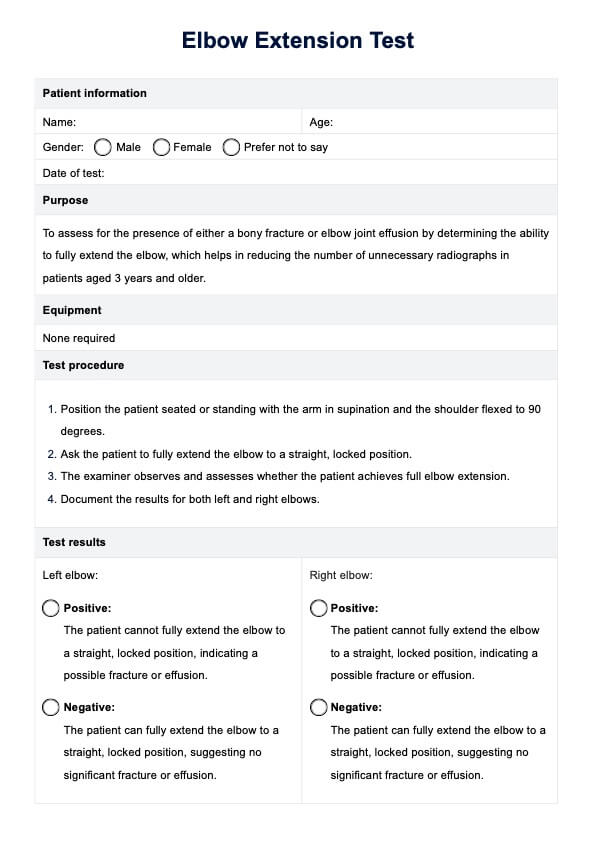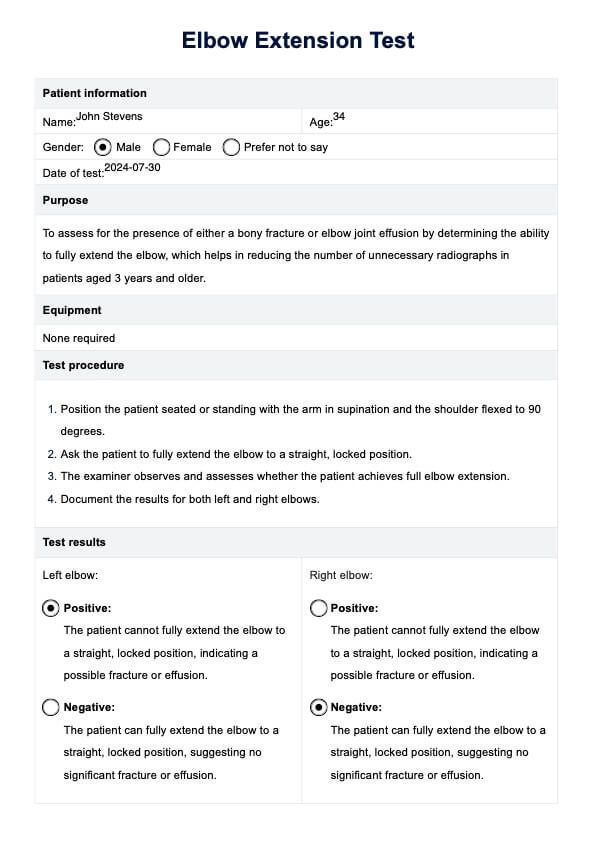Elbow Extension Test
Discover the Elbow Extension Test for diagnosing fractures and joint effusions. Learn about its purpose, procedure, and benefits using our comprehensive template.


What is an elbow joint effusion?
Elbow joint effusion refers to the accumulation of excess fluid within the elbow joint. This condition can result from various underlying issues, such as inflammation, injury, or infection, leading to swelling, pain, and restricted movement. Joint effusion can significantly impact a person's ability to perform daily activities and requires proper diagnosis and treatment to address the root cause and alleviate symptoms effectively.
Symptoms
Elbow joint effusion can present with several symptoms. Common indicators include:
- Swelling around the elbow joint
- Pain or tenderness in the elbow
- Reduced range of motion in the elbow
- A feeling of warmth around the affected area
- Visible redness or discoloration of the skin over the elbow
- Stiffness in the elbow, especially after periods of rest
Causes
There are multiple causes for elbow joint effusion. Key causes include:
- Trauma or injury, such as fractures or sprains
- Inflammatory conditions, such as rheumatoid arthritis or gout
- Infections that affect the joint, like septic arthritis
- Overuse or repetitive strain on the elbow joint
- Degenerative joint diseases, such as osteoarthritis
- Hemophilia or other bleeding disorders
Elbow Extension Test Template
Elbow Extension Test Example
What is an Elbow Extension Test?
The Elbow Extension Test is a clinical decision rule designed to reduce the need for unnecessary radiographs in patients aged three years and older who present with elbow pain. This test specifically assesses the presence of either a bony fracture or clinically significant injury. It involves asking the patient to extend their elbow fully while either standing or sitting. The test's diagnostic accuracy is crucial in assessing its ability to detect elbow fractures, with reported sensitivity and specificity values. The test is positive if the patient cannot fully extend, indicating a possible elbow fracture or effusion (Yaver, 2008).
To conduct the Elbow Extension Test, the patient is positioned with the arm in supination, and the shoulder flexed to 90 degrees. The examiner observes as the patient attempts to extend the elbow to a locked position. Failure to achieve full extension suggests a significant underlying issue, warranting further investigation through imaging or other diagnostic methods.
The test is instrumental in ruling out the need for radiography in patients with acute elbow injuries. This test has a reported sensitivity of 96.8% and specificity of 48.5% for detecting elbow fractures, making it a valuable tool in clinical settings (Appelboam et al., 2008).
Given its high sensitivity, the Elbow Extension Test is beneficial in ruling out fractures when the test result is negative. However, a positive result indicating an inability to extend the injured elbow often fully necessitates further evaluation to confirm the diagnosis and determine the appropriate treatment plan. When interpreting the test results, it is essential to consider the possibility of an olecranon fracture, especially in adults.
How to use our Elbow Extension Test template
Using our Elbow Extension Test template is straightforward and helps ensure accurate assessment and documentation. Follow these steps:
Step 1: Download the template
Download our Elbow Extension Test template from the provided link to ensure you have all the necessary fields for recording patient information and test results.
Step 2: Prepare the patient
Position the patient seated or standing with the arm in supination, exposed and supinated arms, and the shoulder flexed to 90 degrees. Ensure the patient has their supinated arms exposed for accurate assessment. Ensure the patient is comfortable and understands the procedure.
Step 3: Conduct the test
Instruct the patient to extend the elbow to a straight, locked position fully, achieving equal extension. Compare the injured and uninjured sides to assess for any differences in extension. Observe and evaluate whether the patient achieves full extension.
Step 4: Document the results
Record the test results for both the left and right elbows in the template, noting whether the result is positive or negative based on the patient's ability to extend the elbow fully.
Step 5: Analyze and proceed
Analyze the recorded results to determine if further diagnostic steps are needed. Use the documented information to guide your clinical decisions and patient care plans.
Benefits of using our template
Our Elbow Extension Test template ensures a standardized, efficient, and accurate assessment process. Here are three key benefits:
Enhanced diagnostic accuracy
Our template guides you through each step of the Elbow Extension Test, ensuring that all necessary details are captured. This enhances your assessments' accuracy and helps make informed clinical decisions based on consistent and reliable data.
Streamlined documentation
The template provides a structured format for recording patient information and test results, reducing the likelihood of errors and omissions. This streamlines the documentation process, saving time and allowing healthcare professionals to focus more on patient care.
Improved patient care
Our template ensures that the Elbow Extension Test is conducted and documented thoroughly. This leads to better diagnosis and treatment planning, ultimately improving patient outcomes. The clear and concise documentation also facilitates effective communication among healthcare providers.
References
Appelboam, A., Reuben, A. D., Benger, J. R., Beech, F., Dutson, J., Haig, S., Higginson, I., Klein, J. A., Le Roux, S., Saranga, S. S., Taylor, R., Vickery, J., Powell, R. J., & Lloyd, G. (2008). Elbow extension test to rule out elbow fracture: multicentre, prospective validation and observational study of diagnostic accuracy in adults and children. BMJ, 337, a2428. https://doi.org/10.1136/bmj.a2428
Yaver, J. (2008). The users’ guide to the musculoskeletal examination: Fundamentals for the evidence-based clinician. Physical Therapy, 88(12), 1605–1606. https://doi.org/10.2522/ptj.2008.88.12.1605
Commonly asked questions
The Elbow Extension Test is used to assess for the presence of a bony fracture, significant injury, or elbow joint effusion and determine whether further diagnostic imaging is necessary.
The patient is asked to extend their elbow while the examiner observes fully, assessing both elbow extension and flexion. If the patient cannot achieve full extension, the test is positive, indicating a possible fracture or effusion.
Symptoms include swelling, pain, reduced range of motion, warmth around the joint, redness, and stiffness, especially after periods of rest. These symptoms are often associated with elbow joint effusion and elbow injury.
Causes include trauma, inflammatory conditions like arthritis, infections, overuse, degenerative diseases, bleeding disorders, and issues related to the upper arm.
If the test indicates an inability to extend the elbow fully, further evaluation through imaging or other diagnostic methods, including the assessment for olecranon fractures, is recommended to confirm the diagnosis and determine appropriate treatment.







































































































